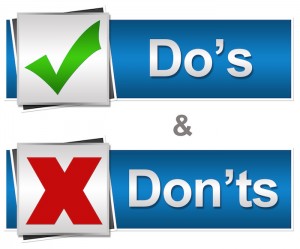Kim Virrueta
December 8, 2012
Image Credit:
Site Navigation Do's and Don'ts
Updated on April 23, 2013
To give your website visitors the ability to find information quickly is the very best way to help your medical practice marketing efforts pay off.
For each visitor who lands on your site, there is a reason why they came. With these site navigation do’s and don’ts, yours will help keep visitors engaged and increase the chances that they will book a consultation.
Website Navigation Do’s
- Make sure your navigation menu includes the most-desirable sections on your site. This will allow an easy way for patients to find exactly what they came for in those few, precious seconds you have to capture their attention. We recommend a top navigation menu that includes (from left to right): About, Gallery, Procedures, Resources, Pricing, Blog, Contact. Even if you choose not to list your pricing, make a way on your Pricing page for patients to fill out a request form (or call you) with specific information you need from them in order to provide an estimated price. Under your menu items you can also have sub-menu items such as "testimonials" under your "about" section, each of your procedures listed under the "procedures" section, etc.
- Make sure all of your links are working. There’s nothing worse than blowing your site visitor’s opinion of you than having links that lead to 404 error pages. They are almost 100% likely to click out of your site if your links don't work. This type of poor website maintenance is not only bad for your search engine rankings; it is bad for your reputation with patients.
- Include one testimonial statement on your “Contact Us”. This is a great way to let your happy patients do the talking for you!
- Have a library of educational articles and videos for your patients to check out. By providing them with solid information about procedures, they will come to trust you to as their doctor of choice.
- We also recommend testimonial videos, a page dedicated to places where patients can read reviews about you (or leave their own), and social media sharing buttons on every page of your site for easy sharing with others.
- Have a way to capture email addresses right on your website. Offer something for free, have a giveaway every so often, entice them with special "email subscriber-only" promotions, or come up with your own creative way of getting those email addresses. Don't forget to ALWAYS get emails from your consultations and to get opt-in permission on their new patient paperwork to add them to your newsletter list.
Website Navigation Don’ts
- Don’t leave out critical pieces of your site. For example, a site map and privacy policy are two things that Google looks for on any web site. In fact, some patients may also be looking for you to have these pages as well.
- Don’t make it hard for patients to find your contact information. Some medical practices forget this huge part of the equation and just include a form on their site. Be sure to include practice hours and days of operation, address information with a Google Local or Maps link, email address, and phone number.
- Don’t lay your navigation menu out in a confusing manner. Your site navigation should follow a logical progression that groups topics into similar areas with each other. If a patient is looking for an article about a tummy tuck procedure, make sure your navigation menu shows how they can get there. For example, it might be organized like this: Home>Procedures>Tummy Tuck.
Need Better Website Navigation & Design?
By following these tips for site navigation best practices, your site will make it easy for visitors to find what they need and portray the most professional image of you and your medical practice. Need someone to do an overhaul and redesign of your website? Contact us today for help and see what a fresh, new design can do for you.


Comments